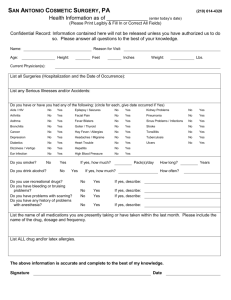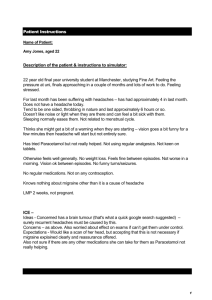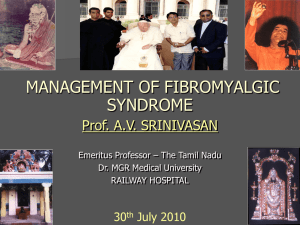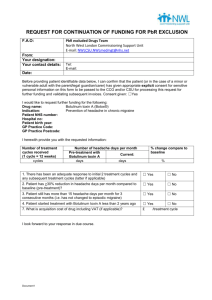migraine
advertisement
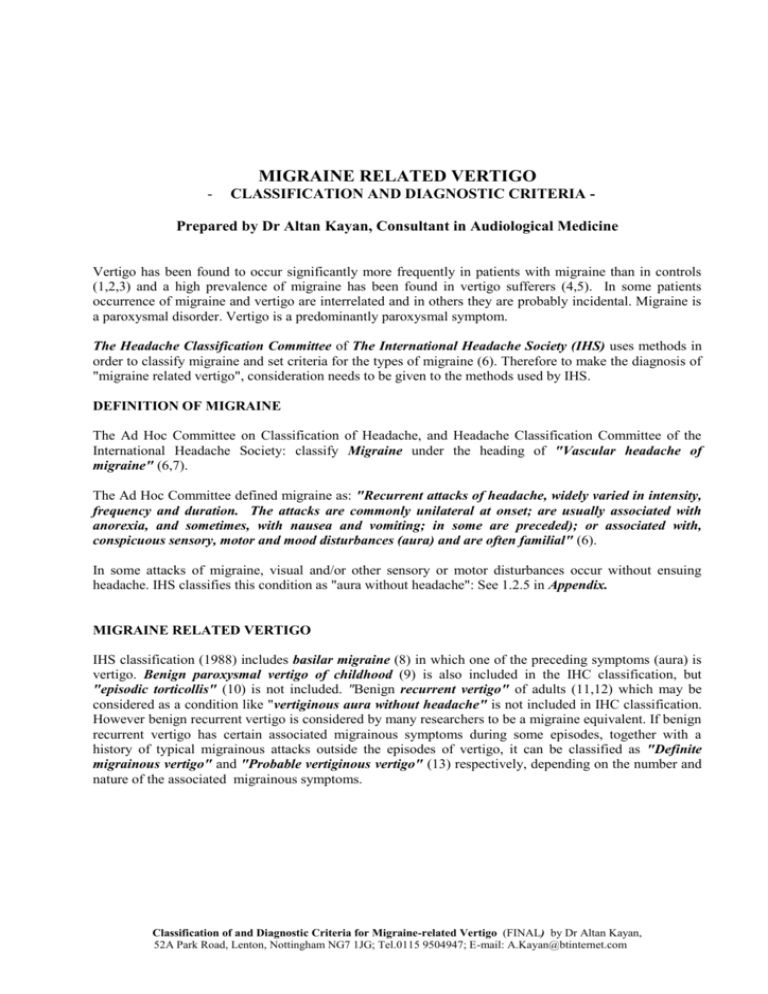
MIGRAINE RELATED VERTIGO - CLASSIFICATION AND DIAGNOSTIC CRITERIA - Prepared by Dr Altan Kayan, Consultant in Audiological Medicine Vertigo has been found to occur significantly more frequently in patients with migraine than in controls (1,2,3) and a high prevalence of migraine has been found in vertigo sufferers (4,5). In some patients occurrence of migraine and vertigo are interrelated and in others they are probably incidental. Migraine is a paroxysmal disorder. Vertigo is a predominantly paroxysmal symptom. The Headache Classification Committee of The International Headache Society (IHS) uses methods in order to classify migraine and set criteria for the types of migraine (6). Therefore to make the diagnosis of "migraine related vertigo", consideration needs to be given to the methods used by IHS. DEFINITION OF MIGRAINE The Ad Hoc Committee on Classification of Headache, and Headache Classification Committee of the International Headache Society: classify Migraine under the heading of "Vascular headache of migraine" (6,7). The Ad Hoc Committee defined migraine as: "Recurrent attacks of headache, widely varied in intensity, frequency and duration. The attacks are commonly unilateral at onset; are usually associated with anorexia, and sometimes, with nausea and vomiting; in some are preceded); or associated with, conspicuous sensory, motor and mood disturbances (aura) and are often familial" (6). In some attacks of migraine, visual and/or other sensory or motor disturbances occur without ensuing headache. IHS classifies this condition as "aura without headache": See 1.2.5 in Appendix. MIGRAINE RELATED VERTIGO IHS classification (1988) includes basilar migraine (8) in which one of the preceding symptoms (aura) is vertigo. Benign paroxysmal vertigo of childhood (9) is also included in the IHC classification, but "episodic torticollis" (10) is not included. "Benign recurrent vertigo" of adults (11,12) which may be considered as a condition like "vertiginous aura without headache" is not included in IHC classification. However benign recurrent vertigo is considered by many researchers to be a migraine equivalent. If benign recurrent vertigo has certain associated migrainous symptoms during some episodes, together with a history of typical migrainous attacks outside the episodes of vertigo, it can be classified as "Definite migrainous vertigo" and "Probable vertiginous vertigo" (13) respectively, depending on the number and nature of the associated migrainous symptoms. Classification of and Diagnostic Criteria for Migraine-related Vertigo (FINAL) by Dr Altan Kayan, 52A Park Road, Lenton, Nottingham NG7 1JG; Tel.0115 9504947; E-mail: A.Kayan@btinternet.com 2 The following is the proposed classification of and diagnostic criteria for "migraine related vertigo": I BASILAR MIGRAINE (included in IHS classification of migraine) "Basilar migraine" consists of aura and headache. The AURA should include at least two of the following: vertigo, tinnitus, decreased hearing, ataxia, dysarthria, double vision, hemifield visual symptoms (both eyes and both fields), bilateral paraesthesia, bilateral hemiparesis, decreased level of consciousness. HEADACHE is pulsatile and predominately occipital, accompanied by nausea/vomiting, photoand phonophobia. Other causes ruled out by history, physical examination and other appropriate investigations. II DEFINITE MIGRAINOUS VERTIGO (Modified from H. K. Neuhauser, et al, 2001 (13); not included in IHS classification) III Episodic vestibular symptoms of at least moderate severity (rotational vertigo, other illusory self or object motion, positional vertigo, head motion intolerance). At least two of the following migrainous symptoms during at least two vertiginous attacks: (a) migrainous headache; (b) photophobia, (c) phonophobia; (d) visual or other aurae. Attacks of migraine (outside episodes of vertigo) according to IHS criteria. Some central and/or peripheral vestibular abnormalities may be found in vertigo-free periods. Other causes ruled out by history, physical examination and other appropriate investigations. PROBABLE MIGRAINOUS VERTIGO (Modified from H. K. Neuhauser, et al, 2001 (13); not included in IHS classification) Episodic vestibular symptoms of at least moderate severity (rotational vertigo, other illusory self or object motion, positional vertigo, head motion intolerance) At least one of the following, in relation to at least one vertiginous attack: (a) migrainous headache, (b) photophobia, (c) phonophobia, (d) migraine-specific triggers e.g. specific foods, sleep irregularities, hormone changes Response to migraine prophylactic drugs. Migraine (outside vertiginous attacks) according to the criteria of the IHS Some central and/or peripheral vestibular abnormalities may be found in vertigo-free periods. Other causes ruled out by history, physical examination and other appropriate investigations. 3 IV POSSIBLE MIGRAINOUS VERTIGO BENIGN RECURRENT VERTIGO (11,12) (not included in IHS classification of migraine) Episodic vertigo, occasionally with tinnitus but without hearing loss May be accompanied by nausea/vomiting and ataxia Nystagmus may be observed during the episode Duration: minutes to hours, usually less than one hour ( 11), or hours to days (12) Episodes of migrainous headaches outside vertiginous episodes, and/or positive family history of migraine. Normal audiometric findings, or no asymmetry if there is an incidental hearing loss Differential diagnosis: vestibular hydrops, other episodic vestibular disorders, epilepsy V CHILDHOOD PERIODIC SYNDROMES THAT MAY BE PRECURSORS TO OR ASSOCIATED WITH MIGRAINE A BENIGN PAROXYSMAL VERTIGO OF CHILDHOOD (included in IHS classification of migraine) Episodes of vertigo or dysequilibrium without hearing loss or tinnitus Accompanied by visual flashing, nausea/vomiting, pallor, agitation and ataxia. Headache not a usual feature First decade of life, commonly at ages of one to four years Duration: usually minutes, sometimes hours Positive family history of migraine, and many develop migraine with aurae in older ages Other causes ruled out. Differential diagnosis: Meniere’s disease, vestibular epilepsy, perilymphatic fistula, posterior fossa tumours and psychogenic disorders B PAROXYSMAL TORTICOLLIS OF INFANCY (not included in IHS classification of migraine) Episodes of head tilt or rotation without vertigo, hearing loss or tinnitus Accompanied by nausea/vomiting, pallor, agitation and ataxia Vestibular function is normal between the episodes Neurological causes ruled out e.g. posterior fossa tumour First five years of life Usually migraine in the family, and many develop migraine at older ages VI NEURO-OTOLOGICAL DISORDERS, POSSIBLY MIGRAINE (not included in IHS classification of migraine) ASSOCIATED WITH (a) MOTION SICKNESS: High prevalence of history of motion sickness in migraineurs (1,2). (b) MENIERE’S DISEASE: High prevalence of migraine in population with Meniere’s disease; and high prevalence of Meniere’s disease in migraineurs (4,5). Some cases have been reported to experience migraine aurae in the form of Meniere’s symptoms’ complex (5). (c) POSITIONAL VERTIGO: The prevalence of benign paroxysmal positional vertigo has been reported to be high in migrainous population. Migraine related central positional vertigo, has also been reported to occur in bouts, lasting a few days at most. If the patient is seen during a bout, central positional nystagmus is observed (6). 4 REFERENCES (1) Kuritzky, A., Ziegler, D. K., and Hassanein, R. (1981) Vertigo, motion sickness and migraine. Headache, 21: 227-231. (2) Kayan, A. and Hood, J. D. (1984) Neurological Manifestation of Migraine. Brain, 107: 1123-1142. (3) Herdman, S.J. (2000) Diagnosis and management of neuro-otological disorders due to migraine In: Vestibular Rehabilitation, second edition, chapter 13, pp: 298-315. F.A. Davis Company, Philadelphia. (4) Hood, J. D. and Kayan, A. (1985) Neuro-otology and migraine. In: Migraine, Ed: N. J. Blau; Chapter 35, pp: 597-624. Bruyn, Netherlands. (5) Rassekh, C.H. and Harker, L. A. (1992) The prevalence of migraine in Meniere's disease. Laryngoscope, 1992: 135-138. (6) Headache Classification Committee of the International Headache Society (1988): Classification and diagnostic criteria for headache disorders, cranial neuralgias and facial pain. Cephalalgia 8 (suppl. 7): 1- 97. (7) Ad Hoc Committee on Classification of Headaches of the NIH (1962) JAMA, 179: 717-718. (8) Bickerstaff, E. R. (1961) Basilar artery migraine. Lancet, 1: 15-17. (9) Basser, L. S. (1964) Benign paroxysmal vertigo of childhood. Brain, 87: 141-152. (10) Snyder, C. H. (1969) Paroxysmal torticollis in infancy. Am. J. Dis. Child, 117: 458 - 460. (11) Slater, R. (1979) Benign recurrent vertigo. J. Neurol. Neurosurg. Psychiat., 42: 363-367. (12) Moretti, G., Manzoni, G. C. and Parma, M. (1980) "Benign recurrent vertigo" and its connection with migraine. Headache 20: 344-346. (13) Neuhauser, H. K., Leopold, M, von Brevern M, Arnold, G, Lempert, T. (2001) The interrelations of migraine, vertigo, and migrainous vertigo. Neurology, 56: 436-441. 5 APPENDIX MIGRAINE - CLASSIFICATION AND DIAGNOSTIC CRITERIA The following gives the diagnostic criteria for cardinal types of migraine and migrainous conditions relevant to "migraine related vertigo" within the criteria set the by the Headache Classification Committee of International Headache Society (IHS) (1988). 1.1 Migraine without aura (replaces "common migraine"). A. At least 5 attacks fulfilling criteria B-D B. Headache attacks lasting 4 to 72 hours untreated. In children <15 years, attack may last 2 to 48 hours. C. Headache has at least two of the following characteristics: 1. Unilateral location. 2. Pulsating quality. 3. Moderate or severe intensity that inhibits or prohibits daily activities. 4. Aggravation by walking stairs or similar routine physical activity. D. During headache at least one of the following: 1. Nausea and/or vomiting. 2. Photophobia and phonophobia. E. At least one of the following: 1. History and physical examinations do not suggest another disorder. 2. History and physical examination do suggest such disorder, but it is ruled out by appropriate investigations (e.g., MRI or CT scan of the head). 1.2 Migraine with aura (replaces "classic migraine"). A. At least 2 attacks fulfilling B: B. At least 3 of the following: 1. One or more reversible aura symptoms indicating focal CNS dysfunction. 2. At least one aura symptom develops gradually over more than 4 minutes, or 2 or more symptoms occur in succession. 3. No aura symptom lasts more than 60 minutes unless more than one aura symptom is present. 4. Headache occurs either before, during, or up to 60 minutes after aura is completed. C. Same as E above in criteria 1.1. 1.2.2 Migraine with prolonged aura (replaces "complicated migraine"). Fulfills criteria for 1.2, but at least one symptom lasts more than 60 minutes and less than 7 days. 6 1.2.4 Basilar migraine (replaces basilar artery migraine). Fulfills criteria for 1.2, but two or more aura symptoms of the following types: Vertigo, tinnitus, decreased hearing, ataxia, visual symptoms in both hemifields of both eyes, dysarthria, double vision, bilateral paraesthesia, bilateral paresis, decreased level of consciousness. 1.2.5 Migraine aura without headache (replaces migraine equivalent or acephalic migraine) Fulfils criteria for 1.2 but no headache. 1.5 Childhood periodic syndromes e.g. cyclic vomiting and periodic abdominal pain that may be precursors to or associated with migraine. 1.5.1 Benign paroxysmal vertigo of childhood. A. Brief, sporadic episodes of dysequilibrium, anxiety, and often nystagmus or vomiting. B. Normal neurological examination. C. Normal electroencephalogram. 1.6.2 Migrainous infarction (replaces "complicated migraine"). A. Patient has previously fulfilled criteria for 1.2. B. The present attack is typical of previous attacks, but neurological deficits are not completely reversible within 7 days and/or neuro-imaging demonstrates ischaemic infarction in relevant area. C. Other causes of infarction ruled out by appropriate investigations. _________________________________________________________ Migraine Related Vertigo - Classification and Diagnostic Criteria. by Dr Altan Kayan, 3rd October 2003. 52A Park Road, Lenton, Nottingham NG7 1JG; Tel.0115 9504947 E-mail: A.Kayan@btinternet.com
